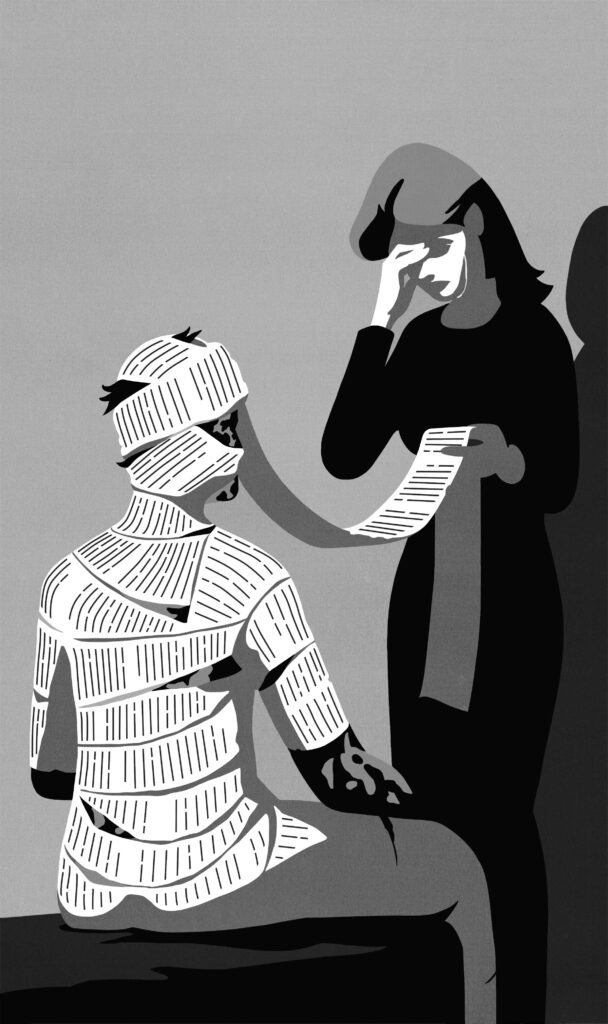Readers be warned: Burn Man is not for the faint of heart. The grim stories in this collection will not counter the darkness of our present moment, but they will command attention, for there is much to admire in Mark Anthony Jarman’s work. This is a writer who possesses stylistic mastery and an ability to evoke character and incident using the barest of details. His are inimitable protagonists — wounded and nameless men with a gift for irony and humour — who inhabit haunting worlds.
Jarman is an award-winning author who teaches creative writing at the University of New Brunswick in Fredericton. He is a graduate of the Iowa Writers’ Workshop, where he was influenced by Barry Hannah, a “wild” prose writer from Mississippi. Hannah’s imagination —“calibrated to the short burst”— certainly aligned with Jarman’s aesthetic. Several prominent writers have noticed Jarman’s technical virtuosity. A. S. Byatt gave him high praise for work that is “brilliant,” “extraordinary,” and “gripping.” Douglas Glover lauded his intoxicating and “playful” use of “sound and rhythm and repetition.”
In introducing this volume, the critic and editor John Metcalf characterizes Jarman as a “language performer” and a “builder of rhetorical structures.” Indeed, as Jarman himself describes them, these inventive and effective short stories often resemble “pastiche or collage.” They “smash together matters of head and heart” to pack a punch. In tale after tale, “jagged” language and innovative fragmentation conjure life’s “accidental and brutal” reversals.

We come to care for these nameless men.
M.G.C.
Burn Man brings together twenty-one stories, chosen by Jarman and arranged not by date of original publication but by resonant effect. The book opens with “Burn Man on a Texas Porch,” which Byatt famously labelled “something new.” The story first appeared in 2000, among the pages of Jarman’s 19 Knives, and its key elements — violence and horror, personal loss and existential suffering — set the stage for the present collection.
A propane tank leaks and catches fire while the protagonist is asleep in his camper. He springs awake, with flames “living” on his calves and “glittering” on his shoulders, and rushes outside to his “new life.” His face and body badly burned, he is hospitalized and undergoes many skin grafts, but he remains terribly scarred. Eventually, he comes to think of himself “in third person” as Burn Man, his unfortunate “double.” To earn a living, Burn Man must disguise himself, which he does by donning costumes — a clown, a rabbit, a mascot — to entice retail customers or to entertain sports fans.
A clear-eyed acceptance of his “difficult and lewd” present contrasts with Burn Man’s poignant remembrance of tenderness and love. In his current disfigured state, he connects with a kind escort. But as a “milky youth,” when his “skin was soft,” he had loved a woman in Texas. He recalls kissing her on a porch, “with her tongue arranging hope in my mouth.” The persistence of wish and desire in the face of affliction — he yearns “for the right fire to twist me back”— is a stunning assertion of life’s value even in the darkest times.
Devastating accidents mark the lives of many of Jarman’s characters. In “19 Knives,” a young boy wakes up in the middle of the night. “Half asleep” and thirsty, he opens the fridge and reaches for his father’s orange juice, which is laced with methadone. The lad is rushed to hospital, but “it was no good.” In “Knife Party” and “The Hospital Island,” two stories that seem to build upon one another, a father and daughter live in a Naples apartment. During a rowdy gathering across the hall, the father is stabbed in the leg. The knife severs his femoral artery, and he dies — his “body twitching” in the arms of his “weeping daughter.” In “The Scout’s Lament,” a dad encourages his son to play hockey. The talented boy is just sixteen when a vicious opponent “drills” him “in the face going down.” He abandons the sport, but his father cannot give it up — despite the burning memory of “that needle moving through” the teenager’s cheek.
Among the more shocking stories is “Dangle,” about another father who must live with the results of his deed. Each night he returns from work to play with his young sons. He learned the joy of roughhousing from his own father, who used to dangle him over the banister in a dangerous game of catch and release. One evening there’s “a mistake,” and the man loses the “fleeced ankles” of his littlest boy. “No laws were broken,” he concedes. His favourite son “obeyed gravity” and fell “straight down,” as if he were “a heavy blond bomb dropped in a blue sleeper.” In a coma, the child “lives on in limbo,” attached to life-support machines. The narrator’s marriage has ended, and he is alone. Confession does not assuage his guilt, and so he drinks and listens to music. Nothing helps, though: “I’m with my baby in limbo.” With this carefully chosen repetition, Jarman reveals an exquisite capacity to expose the depths of grief.
Several stories feature the same protagonist who is struggling to come to terms with his “wrecked” marriage. While his wife, Natasha, is moving out of their home, he decamps for Italy. There he meets his cousin Eve, and together they discover the beauty of “peach-coloured” Rome. The two wander the city, “walk fountain to fountain, drift palace to palace, painting to painting.” Soon they form a deep bond, and Eve becomes the man’s “new confessor.” But she is also beautiful and, in the wake of the protagonist’s ruined union, arouses longing. The narrator of these linked stories is keenly aware of the complexity of his feelings: “The anatomy of desire and the anatomy of loss — I have them mixed up in my depressed, sunburnt head.” This statement is characteristic as well of Jarman’s other protagonists, who perceive their flaws, take responsibility for their failings, and endure the repercussions of their actions. Outwardly, they may appear tough and stalwart. Inwardly, they are vulnerable and are often shattered by the circumstances of their lives. While some difficulties are of their own making, others are random. They grasp this incontrovertible duality and face their torment, knowing the only answer is to “embrace it purely, wantonly, for we are alive, we are free.”
That the reader feels compassion for these men is due to Jarman’s humanism and writerly skill. What happens to his characters touches us, and we come to care for them. We want to reach out, offer a gentle hand and a kind word, for we are like them, fighting to find meaning in this “lunatic world.”
Ruth Panofsky teaches English literature at Toronto Metropolitan University. She recently received the Royal Society of Canada’s Lorne Pierce Medal.
Related Letters and Responses
Wayne Jones St. John's

